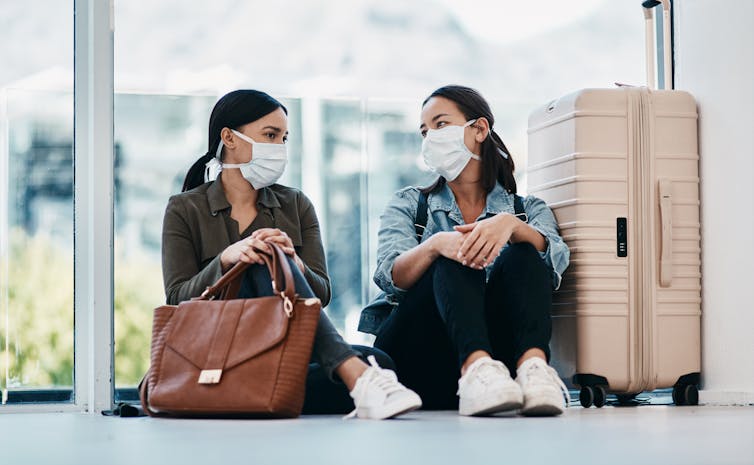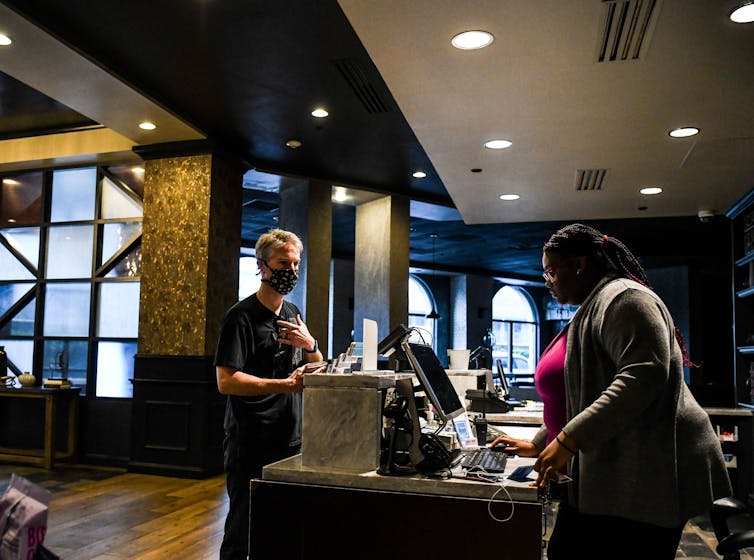Is it safe to stay in a hotel, cabin or rental home yet?
- Written by Elizabeth Marder, Instructor, Department of Environmental Toxicology, University of California, Davis
After nearly three months of quarantine, millions of Americans are ready to travel – an overnight trip, a weekend getaway, a summer sojourn. With states reopening, that’s now possible, with a caveat. Before coronavirus, few people likely thought twice about staying in a hotel room, rental home or cabin in the woods. But now, we have to factor in the potential for coronavirus exposure. Even if you’re OK with the travel risks[1] taking you to your destination – plane, train or automobile – what about the risks of the destination spot itself?
We are both exposure scientists. One of us[2] feels comfortable booking a “no-contact” stay; the other[3] still isn’t sure whether to take an overnight trip anytime soon. But we agree on two things: Traveling these days brings increased risk, yet ways exist to minimize that risk.
 Wearing face masks is still important, especially when traveling.
Getty Images / PeopleImages[4]
Wearing face masks is still important, especially when traveling.
Getty Images / PeopleImages[4]
The issues
Centers for Disease Control and Prevention guidance[5] is clear that travel heightens your chance of getting or spreading COVID-19. The travel industry is taking this seriously. Both the American Hotel & Lodging Association[6] and Vacation Rental Management Association[7] have released best practice guidelines and standards.
No matter what type of stay you’re planning, the primary concern is coming into close contact (less than six feet) with an infected person. That probability is higher when you travel. Keep in mind a person with COVID-19 can spread the virus[8] before developing symptoms. From the start, you must assume that everyone around you may be infected. Including yourself.
Contact with contaminated surfaces is of less concern, but still something to consider. We are learning more about the potential for infections[9] from them, but we do know coronavirus has been detected on guest room surfaces[10]. Try to minimize your contact with surfaces – tabletops, chairs, bathroom sinks, duvet covers – that haven’t been cleaned or disinfected.
A further complication: The pattern and extent of COVID-19[11] can vary between communities, even in the same region. Laws and public health guidelines vary as well, so make sure you check for updates before traveling.
 A tourist checks into a hotel in Savannah, Ga., on April 25, 2020, shortly after Georgia Gov. Brian Kemp lifted some social distancing measures.
Chandan Khanna/AFP via Getty Images[12]
A tourist checks into a hotel in Savannah, Ga., on April 25, 2020, shortly after Georgia Gov. Brian Kemp lifted some social distancing measures.
Chandan Khanna/AFP via Getty Images[12]
Before you book
There’s no way to make a stay 100% safe, but there are certainly ways to make a stay safer. Remember each lodging scenario is different; for example, unlike hotels or rental homes, campgrounds typically have only shared bathrooms[13]. But wherever you may stay, start by checking out the establishment’s website, or call to ask what management is doing to reduce transmission risk.
Make sure to ask about:
Air quality. Cleaning with approved products[14] should be frequent. Ask if hand washing or hand sanitizing stations are available in common areas. Engineering controls, like increasing air exchange or HEPA filters in the ventilation system, should be in place. If that’s not the case, consider bringing a portable air purifier with a HEPA filter. On the low-tech side: Can windows be opened for better air flow? A fan can help bring in more outdoor air and increase the mixing rate if used near an open window.
No-contact options, like digital keys.
Policies on masks and health screenings for guests and staff.
Is the rental business limiting capacity to promote distance? That is, are they booking only every other room? And are they preventing one-night stays, which would bring in more people and therefore introduce more risk? Avoid lodgings with same-day turnovers.
Strategies for a safer stay
Once you’ve determined the management is doing all it can, you need to do all you can to minimize exposure. Wear a face covering and practice social distancing in common areas. Minimize time in enclosed, less ventilated spaces, like elevators. Avoid contact with “high-touch” surfaces in shared spaces, like the elevator call button, door handles, and dining tables and chairs; they are less likely to have been disinfected between each individual’s touch. Wash your hands or use hand sanitizer after spending time in common areas. If gyms and pools are open, remember to social distance, wear your mask, and wipe down equipment before and after use.
Use plastic zip bags for personal items that others may handle. That includes your driver’s license, credit card and key. Bring extra bags to put these things in after you disinfect them. Handle your own luggage, or arrange for no-contact delivery.
Disinfect surfaces following CDC guidance[15]. If housekeeping is available, opt out. Request that decorative pillows and duvet covers be removed before your arrival.
Lowest-risk options for dining: bring your own food or do room service or no-contact delivery. Outdoor dining can be a reasonable option, but if you dine inside, make sure there’s reasonable ventilation and adequately spaced tables.
Bring enough masks or face coverings for each day, or bring detergent to wash between uses. You’ll also need hand sanitizer or hand wipes, a surface disinfectant, paper towels and disposable disinfectant wipes.
All this helps, but remember: Even doing everything on this substantial list still may not eliminate your chance of getting the virus. The bottom line is, we don’t recommend nonessential travel for everyone right now. You may need a vacation, but COVID-19 never takes one.
[Get facts about coronavirus and the latest research. Sign up for The Conversation’s newsletter.[16]]
References
- ^ travel risks (theconversation.com)
- ^ One of us (scholar.google.com)
- ^ the other (scholar.google.com)
- ^ Getty Images / PeopleImages (www.gettyimages.com)
- ^ Centers for Disease Control and Prevention guidance (www.cdc.gov)
- ^ American Hotel & Lodging Association (www.ahla.com)
- ^ Vacation Rental Management Association (www.vrma.org)
- ^ can spread the virus (doi.org)
- ^ potential for infections (www.nejm.org)
- ^ guest room surfaces (doi.org)
- ^ pattern and extent of COVID-19 (coronavirus.jhu.edu)
- ^ Chandan Khanna/AFP via Getty Images (www.gettyimages.com)
- ^ shared bathrooms (theconversation.com)
- ^ approved products (www.epa.gov)
- ^ CDC guidance (www.cdc.gov)
- ^ Sign up for The Conversation’s newsletter. (theconversation.com)
Authors: Elizabeth Marder, Instructor, Department of Environmental Toxicology, University of California, Davis
Read more https://theconversation.com/is-it-safe-to-stay-in-a-hotel-cabin-or-rental-home-yet-140211

